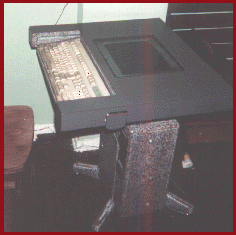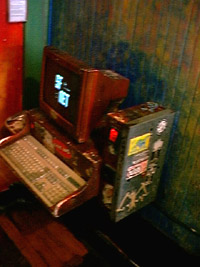

SFNET - a Model for a Usable, Low Cost Public Network
In San Francisco, sit-down terminals (the sort that house mid-1980s videogame machines) housed basic computer terminals, connected via low speed 1200 baud modems to a bulletin board service called SFNET. By inserting 25c into the coin slot, café goers could log onto a bulletin board service linking cafes across the city. By 1995 the system enabled connection to the Internet via text based mouse-free keyboard menus.
 |
This service was a semi grassroots operation run by a single person. SFNET was also for a while a low cost means to get online in San Francisco, offering timed guest accounts for those wanting to use network services in San Francisco to find housing, food and company.
I was impressed with the public spirited nature of SFNET, and its understanding of the role played by cafes in the social life of San Francisco. This city above all others in the United States has privileged the easy laidback culture of café society, and through its cafes, movements such as the beatniks, and the hippies emerged.
The SFNET project seemed to embody the principle of networked services as an adjunct to actual street life, linking events, people and spaces via an informal web of information specific to that city. The democratic nature of SFNET was very much part of the community based ethos and open spirited nature of the city itself. It was deliberately tied to the actual locale of San Francisco, not to an abstract notion of a ‘virtual’ city’ for its own sake.
 |
Like the Digital Cities Project based in Amsterdam, SFNET was quintessentially of the city it grew from within. Both cities share a something of a tradition of openness to outsiders and to unconventional ideas. Both cities saw extraordinary levels of experimentation during the years of the late 1960s ‘counterculture’.
The idea of a public kiosk with resources of use to the population later informed the idea of the EMU web kiosk.
This could partially account for why the computer revolution started originally in and around the Bay Area. Cupertino, home of Apple computer, and Palo Alto, home to Xerox PARC, initiator of the idea of the production line based graphical-user interface, are both within driving distance of San Francicso.